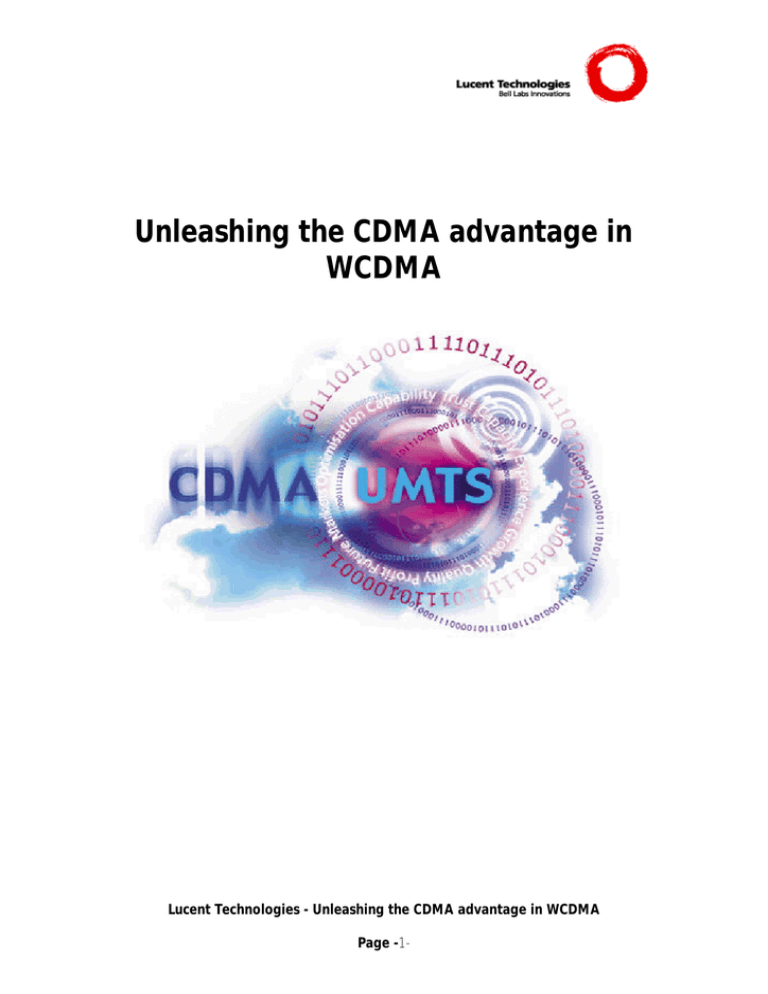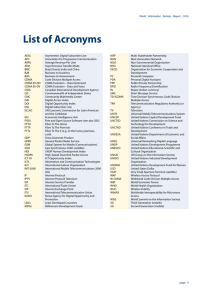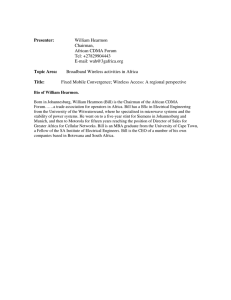Unleashing the CDMA advantage in WCDMA Page -
advertisement

Unleashing the CDMA advantage in WCDMA Lucent Technologies - Unleashing the CDMA advantage in WCDMA Page -1- Unleashing the CDMA advantage in WCDMA The air interface selected for UMTS is Wideband Code Division Multiple Access (WCDMA). This solution offers operators a number of significant advantages over alternative technologies, including increased network capacity, longer battery life for terminals and enhanced privacy for users. However, such benefits come at the cost of additional network complexity. This is why a background in GSM deployment is no guarantee of success in UMTS. However, many of the complexities associated with UMTS are familiar to those with a background in CDMA deployment. Operators moving to UMTS need to draw on the experience of technicians and vendors with a track record in CDMA. Lucent estimates that operator spending on the radio access component of UMTS networks will account for more than 60 per cent of total capital expenditure. For this reason a robust network implementation is critical if operators are to maximise infrastructure investment. Such an approach will allow them to optimise capacity levels and enable the multimedia services that are a key element of the UMTS value proposition. CDMA is the industry’s most sophisticated air interface. WCDMA adds to its complexity. However, high performance radio access is critical to the success of UMTS and code division schemes allow network operators to make the most of their scarce radio spectrum allocation. For example, in the context of 2G systems, it is estimated that a cdmaOne network can offer 30 per cent more capacity than a GSM network with the same spectrum allocation. The history of wireless has repeatedly demonstrated that capacity is invariably consumed faster than the industry predicts. With the imminent arrival of bandwidth hungry high-speed data applications, the advantages of the efficiencies inherent in code division technology become apparent. Such efficiencies can best be grasped when we contrast CDMA with GSM - the most successful implementation of time division and frequency division technology. Imagine you are making a mobile call via a GSM network. If another individual were making a call in a neighbouring cell on the same frequency, the co-channel interference created would disrupt your call. The task of frequency planning is therefore of high importance in GSM: it ensures that channels using similar frequencies are kept apart and interference minimised. GSM allows cell capacity to be readily determined and this means that GSM network planning is relatively straightforward. The downside is that, unless the available radio frequencies can be re-used closer together and repeatedly within the network, spectral efficiency can be limited. In contrast to the frequency planning requirements of GSM, CDMA networks employ universal frequency re-use. This means that all subscribers using a UMTS network transmit simultaneously within the same wideband radio channel. This removes the restriction that each cell employs only a limited number of channels, although it creates the potential for significant co-channel interference. In CDMA networks ‘spread spectrum’ techniques combine the transmission from an individual user with a much faster signal. This process distributes the user’s signal over the whole of the available wideband radio channel. Individual transmissions are identified by means of a unique spreading code allocated by the radio network controller. Each transmission is ultimately Lucent Technologies - Unleashing the CDMA advantage in WCDMA Page -2- reassembled using an identical code to that used in the spreading process. This spread spectrum solution offered by CDMA has no impact on other transmissions on the same network, each of which is allocated its own unique spreading code. As far as other users are concerned, such signals simply appear as low-level noise. So while there is the potential for increased co-channel interference, the spread spectrum technique actually makes the CDMA air interface more robust than other air interfaces. However, it is much more difficult to determine cell capacity in CDMA networks than in their GSM counterparts. The problem is evident in the term ‘soft capacity’ that is often used to describe CDMA cells. This is because in a CDMA network, capacity is dependent on the average level of interference between users. As more connections are made into the network the overall level of interference increases; this in turn affects the call quality of every user connected to the network. Those users furthest from the base station tend to receive the greatest amount of interference and, at some point, could be forced below a signal-to-noise threshold that would normally guarantee acceptable service. This is a feature of CDMA networks known as ‘cell breathing’: the effective service area expands and contracts according to the number of users connected. Overlap-regions between cells (which are known as ‘handover areas’) need careful planning and management. Cell translations and databases must be configured to ensure that handover areas are of optimal size and users furthest from base stations can be successfully ‘handed over’ to neighbouring cells with lighter traffic loads. If these handover areas are too small, mobiles at the edge of a cell will not receive support from the neighbour cells in time. This will result in too much interference and ultimately a dropped call. If the handover area is set too large then too many mobiles will receive multi-cell support, creating unnecessary links into the network that strain call processing resources and reduce capacity. In a CDMA network, mobiles operating at the edge of a cell must be simultaneously supported by the surrounding cells. In this way they become a source of signal strength rather than of interference. Such support – which is known as a ‘soft handover’ - is not required in GSM, where only one cell at a time is required to support a call. However, GSM network planners face a different challenge in the shape of what is known as a ‘hard handover’. In a GSM network, the mobile terminal must change frequencies during the handover between cells. When the terminal is instructed to re-tune to a new frequency there is a momentary period during which the user is disconnected from a traffic channel. This is the point at which the call is most vulnerable to being dropped by the network. Handover complexity in CDMA networks is further increased when multiple wideband carriers are involved. In dense urban areas, several wideband channels may be employed to increase capacity. A lower capacity region utilising only one wideband channel (a ‘common carrier’) often surrounds such an area. In this situation there is a need for a cross-carrier handover - the CDMA version of hard handover. To avoid dropped calls, handovers must be triggered very precisely at the boundary of the handover region. Lucent’s experience with cdmaOne (IS-95) networks has demonstrated that successful handovers are crucial to realising CDMA network performance. This equally applies to WCDMA in UMTS, which must optimally execute soft and hard handovers in order to deliver uninterrupted services. Lucent Technologies - Unleashing the CDMA advantage in WCDMA Page -3- CDMA network performance is highly dependent on the quality of several fundamental algorithms. Handover is one. Further examples include speech compression and power control: Speech compression is used to lower the bit rate at which information must be transmitted on the traffic channel while still being understood at the receiving end. Lower bit rates are important because they correlate directly with lower transmission power that in turn reduces interference. Speech is compressed to the lowest possible link bit rate while still maintaining voice quality. Lucent led the industry in defining the initial vocoder for the IS-95 standard in cdmaOne networks. It also made significant contributions to the enhanced variable rate coder deployed in today’s CDMA networks. Power control over mobile terminal transmissions is a crucial factor in a system that allows all users to share a common radio channel. Power control must be both fast and accurate to cope with continually changing conditions on a network. UMTS will yield enhanced voice capacity in relation to that found in 2G networks. It will also supply a mix of voice and data services, and data users must be allowed to receive brief, controlled bursts of interference in order to achieve higher data rates. IS-95 power control is only partly dictated by standards, so Lucent has continually refined its proprietary algorithms to enhance network performance: this expertise has led to further refinements for UMTS. However sophisticated the air interface, capacity will be lost if the radio access network is not correctly planned and optimised. Antenna orientation, forward power adjustments, handover translations and neighbour lists are all part of this tuning process. Cell planning and optimisation tools like Lucent’s Ocelot take into account propagation effects, irregular network layout and traffic distribution to work out the best antenna configuration for each cell. It has been found that network coverage can be improved by up to 12 per cent and capacity by up to 60 per cent over traditional design techniques. In reality, a trade-off between better coverage and capacity is likely to be the strategy applicable to most situations. The key benefit to operators is that the optimisation can be carried out before deployment, virtually eliminating the need for drive testing. Such a process normally involves weeks of taking measurements and making antenna adjustments in the field. By contrast, Ocelot™ allows networks to be brought on-line much sooner, so that an operator can start generating revenue from the earliest opportunity. To conclude, CDMA air interface technology, basic algorithms and cell planning techniques are radically different to those used in GSM. Operators must expect their potential UMTS vendor to demonstrate both technical leadership and deployment experience in today’s CDMA markets. Only then can they expect to fully realise the levels of radio performance required by tomorrow’s 3G services. Lucent Technologies - Unleashing the CDMA advantage in WCDMA Page -4-


